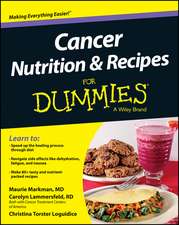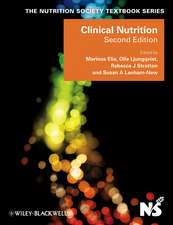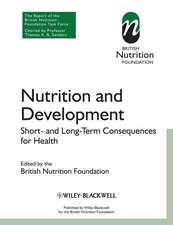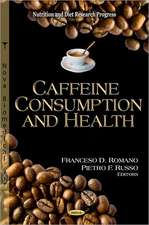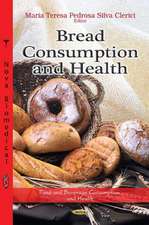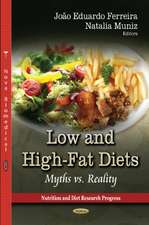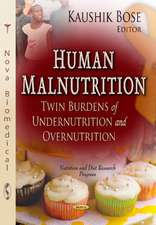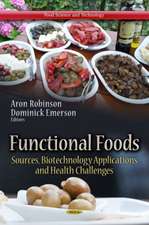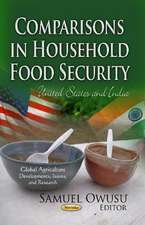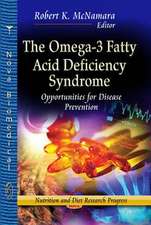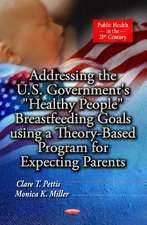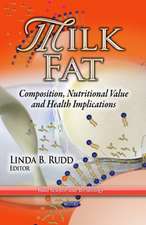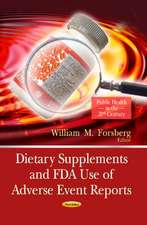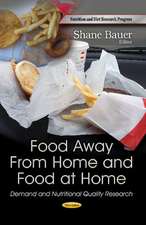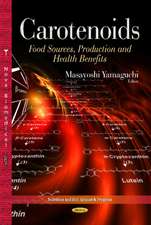Nutrition, Health and Disease – A Lifespan Approach, 3rd Edition
Autor S Langley–Evansen Limba Engleză Paperback – sep 2021
In this newly revised third edition of Nutrition, Health and Disease, prominent researcher and Professor of Human Nutrition Simon Langley-Evans delivers an easy-to-read and student-friendly textbook on the changing demands for nutrients made by the body throughout the human lifespan.
- Thorough introductions to lifespan nutrition, maternal nutrition prior to conception, pregnancy, and the relationship between fetal nutrition and disease later in life
- Practical discussions of lactation and infant feeding, nutrition during childhood, nutrition during adolescence, and nutrition in the adult years
- Detailed examination of contemporary evidence of the relationship between diet, body weight, and the major nutrition-related diseases: cancer, heart disease and diabetes
- Exploration of vegetarian, vegan, and other alternative diets, as well as dieting for weight loss in adults, gender and nutrition, macro- and micronutrients, and a background on nutritional epidemiology
- Access to an updated student companion website with additional resources
Perfect for nutrition and dietetics students, as well as newly qualified nutrition and dietetics professionals, this foundational textbook will also earn a place on the bookshelves of other healthcare students and professionals who seek a one-stop reference on the impact that nutrition has on health and disease.
Preț: 471.59 lei
Preț vechi: 496.41 lei
-5% Nou
Puncte Express: 707
Preț estimativ în valută:
90.24€ • 94.22$ • 74.68£
90.24€ • 94.22$ • 74.68£
Carte disponibilă
Livrare economică 15-29 martie
Livrare express 01-07 martie pentru 52.20 lei
Preluare comenzi: 021 569.72.76
Specificații
ISBN-13: 9781119717515
ISBN-10: 1119717515
Pagini: 416
Dimensiuni: 178 x 254 x 21 mm
Greutate: 0.89 kg
Ediția:3rd Edition
Editura: Wiley
Locul publicării:Chichester, United Kingdom
ISBN-10: 1119717515
Pagini: 416
Dimensiuni: 178 x 254 x 21 mm
Greutate: 0.89 kg
Ediția:3rd Edition
Editura: Wiley
Locul publicării:Chichester, United Kingdom
Notă biografică
Simon Langley-Evans is Head of the School of Biosciences and Professor of Human Nutrition in the Faculty of Science at the University of Nottingham, UK. He obtained his first degree in Biochemistry with Microbiology from Royal Holloway and Bedford New College; his PhD from the University of Southampton, and a DSc from the University of Nottingham. He is the author of over 200 peer-reviewed research papers and book chapters in the area of lifespan nutrition.
Cuprins
Preface ix
Acknowledgements x
Abbreviations xi
Glossary of terms used in this book xii
About the companion website xxiii
1 Introduction to lifespan nutrition 1
1.1 The lifespan approach to nutrition 1
1.2 The concept of balance 2
1.2.1 A supply and demand model 2
1.2.2 Overnutrition 3
1.2.3 Undernutrition 4
1.2.3.1 Increased demand 4
1.2.3.2 The metabolic response to trauma 4
1.2.3.3 Compromised supply and deficiency 6
1.2.3.4 Malnutrition 7
1.2.4 Classical balance studies 11
1.2.5 Overall nutritional status 12
1.3 The individual response to nutrition 12
1.3.1 Stage of the lifespan 13
1.3.2 Genetics 14
1.4 Personalized nutrition 17
1.5 Assessment of nutritional status 19
1.5.1 Anthropometric measures 19
1.5.2 Estimating dietary intakes 20
1.5.2.1 Indirect measures 20
1.5.2.2 Direct measures 21
1.5.3 Biomarkers of nutritional status 24
1.5.4 Clinical examination 25
1.6 Nutritional epidemiology: understanding diet-disease relationships 26
1.6.1 The importance of the evidence base 26
1.6.2 Nutritional epidemiology 26
1.6.3 Cause and effect 27
1.6.4 Bias and confounding 27
1.6.5 Quantifying the relationship between diet and disease 28
1.6.6 Study designs in nutritional epidemiology 29
1.6.6.1 Ecological studies 31
1.6.6.2 Cross-sectional studies 32
1.6.6.3 Case-control studies 33
1.6.6.4 Cohort studies 33
1.6.6.5 Randomized controlled trials 33
1.6.6.6 Systematic review and metaanalysis 34
1.6.6.7 Scoping reviews 34
1.7 Dietary reference values 35
1.7.1 The UK dietary reference values system 36
1.7.2 Dietary reference values in other countries 39
2 Before life begins 45
2.1 Introduction 45
2.2 Nutrition and female fertility 46
2.2.1 Determinants of fertility and infertility 46
2.2.1.1 The endocrine control of female reproduction 47
2.2.1.2 Disordered reproductive cycling 48
2.2.1.3 Polycystic ovary syndrome 48
2.2.2 Importance of body fat 50
2.2.3 Role of leptin 51
2.2.4 Antioxidant nutrients 53
2.2.5 Caffeine and alcohol 55
2.3 Nutrition and male fertility 56
2.3.1 Determinants of fertility and infertility 56
2.3.2 Obesity 60
2.3.3 Alcohol 61
2.3.4 Zinc 61
2.3.5 Antioxidant nutrients 62
2.3.6 Selenium 63
2.3.7 Phytoestrogens and environmental oestrogens 63
2.3.7.1 Phthalates 64
2.3.7.2 Phytoestrogens 64
2.3.7.3 Pesticides 65
2.4 Preparation for pregnancy 66
2.4.1 Why prepare for pregnancy? 66
2.4.2 Maternal weight management 66
2.4.3 Vitamin A and liver 66
2.4.4 Folic acid and neural tube defects 69
2.4.4.1 Supplementation with folic acid 71
2.4.4.2 Fortification with folic acid 71
3 Pregnancy 79
3.1 Introduction 79
3.2 Physiological demands of pregnancy 81
3.2.1 Maternal weight gain and body composition changes 81
3.2.2 Blood volume expansion and cardiovascular changes 82
3.2.3 Renal changes 83
3.2.4 Respiratory changes 83
3.2.5 Gastrointestinal changes 84
3.2.6 Metabolic adaptations 84
3.3 Nutrient requirements in pregnancy 85
3.3.1 Energy protein and lipids 85
3.3.2 Micronutrients 87
3.3.2.1 Iron 87
3.3.2.2 Calcium and other minerals 89
3.3.2.3 Vitamin D 90
3.4 Diet in relation to pregnancy outcomes 91
3.4.1 Miscarriage and stillbirth 91
3.4.2 Premature labour 92
3.4.2.1 Prepregnancy body mass index and pregnancy weight gain 92
3.4.2.2 Alcohol and caffeine consumption 94
3.4.2.3 Oral health 96
3.4.3 Hypertensive disorders of pregnancy 97
3.4.3.1 The aetiology of pre-eclampsia 98
3.4.3.2 Nutrition-related factors and pre-eclampsia 99
3.4.4 Abnormal labour 101
3.5 Nausea and vomiting of pregnancy 102
3.5.1 Nausea and vomiting of pregnancy as a normal physiological process 102
3.5.2 Hyperemesis gravidarum 104
3.6 Cravings and aversions 106
3.6.1 Pica 107
3.7 Gastrointestinal disturbances in pregnancy 108
3.8 High-risk pregnancies 108
3.8.1 Gestational diabetes 108
3.8.2 Adolescent and older mothers 110
3.8.3 Multiple pregnancies 111
3.8.4 Fetal alcohol spectrum disorders 113
4 Fetal nutrition and disease in later life 123
4.1 Introduction 123
4.2 The developmental origins of adult disease 123
4.2.1 The concept of programming 123
4.2.2 Fetal programming and human disease 125
4.2.2.1 Fetal growth 125
4.2.2.2 Nutrition and the constraint of growth 126
4.2.2.3 Fetal growth health and disease 127
4.3 Evidence linking maternal nutrition to disease in later life 129
4.3.1 Epidemiology 129
4.3.1.1 Association of disease with birth anthropometry 129
4.3.1.2 Maternal nutrition and later disease 131
4.3.1.3 Maternal obesity and later disease 132
4.3.2 Criticisms of the programming hypothesis 133
4.3.3 Experimental studies 134
4.3.3.1 Global undernutrition 136
4.3.3.2 Micronutrients 136
4.3.3.3 Macronutrients 137
4.4 Mechanistic basis of fetal programming 138
4.4.1 Thrifty phenotypes and genotypes 138
4.4.2 Mismatched environments 139
4.4.3 Tissue remodelling 139
4.4.4 Endocrine imbalance 141
4.4.5 Nutrient-gene interactions 144
4.4.5.1 Polymorphisms in humans 144
4.4.5.2 Gene expression in animals 145
4.4.6 Epigenetic regulation 145
4.5 Implications of the developmental origins hypothesis 148
4.5.1 Public health interventions 148
4.5.2 Transgenerational transmission of disease risk 149
5 Lactation and infant feeding 157
5.1 Introduction 157
5.2 The physiology of lactation 157
5.2.1 Anatomy of the breast 157
5.2.1.1 The nipple and areola 157
5.2.1.2 The lactiferous ducts 158
5.2.1.3 The lactiferous sinuses 158
5.2.1.4 The alveolar cells 158
5.2.1.5 The rooting reflex 158
5.2.2 Synthesis of milk 158
5.2.2.1 Foremilk and hindmilk 159
5.2.2.2 Time of day 159
5.2.2.3 Course of lactation 160
5.2.2.4 Synthesis of carbohydrates 160
5.2.2.5 Origins of milk fats 160
5.2.2.6 Milk proteins 161
5.2.3 Endocrine control of lactation 162
5.2.3.1 The breast during pregnancy 162
5.2.3.2 Established lactation 162
5.2.3.3 The breast after weaning 163
5.2.4 Maintenance of lactation 164
5.2.5 Nutritional demands of lactation 164
5.3 The advantages of breastfeeding 165
5.3.1 Advantages for the mother 165
5.3.1.1 Convenience and cost 165
5.3.1.2 Bond with infant 166
5.3.1.3 Recovery from pregnancy 166
5.3.1.4 Long-term health 167
5.3.2 Advantages for the infant 168
5.3.2.1 Immunoprotection 168
5.3.2.2 Sudden infant death 169
5.3.2.3 Cognitive development 169
5.3.2.4 Obesity 171
5.3.2.5 Atopy 171
5.3.2.6 Milk contaminants 172
5.3.3 Recommendation to breastfeed for six months 173
5.4 Trends in breastfeeding behaviour 174
5.4.1 Reasons why women do not breastfeed 176
5.4.1.1 Cultural factors 176
5.4.1.2 Technique infection and stress 177
5.4.2 Promoting breastfeeding 178
5.5 Situations in which breastfeeding is not advised 179
5.6 Alternatives to breastfeeding 181
5.6.1 Cow's milk formulas 182
5.6.1.1 Milk stages and follow-on milk 183
5.6.2 Preterm formulas 184
5.6.3 Soy formulas 185
5.6.4 Hydrolysed protein and amino acid-based formulas 185
5.6.5 Other formulas 185
6 Nutrition and childhood 191
6.1 Introduction 191
6.2 Infancy (birth to five) 192
6.2.1 The key developmental milestones 192
6.2.2 Nutrient requirements 193
6.2.2.1 Macronutrients and energy 193
6.2.2.2 Micronutrients 196
6.2.3 Nutrient intakes and infants 197
6.2.4 Transition to an adult pattern of food intake 198
6.2.4.1 Complementary feeding 198
6.2.4.2 Nutrition-related problems 201
6.2.4.3 Barriers to healthy nutrition 206
6.3 Childhood (5-13) 212
6.3.1 Nutrient requirements of the older child 212
6.3.2 School meals and the promotion of healthy eating 213
6.3.3 The importance of breakfast 214
6.4 Obesity in children 215
6.4.1 The rising prevalence of obesity 215
6.4.2 The causes of obesity in childhood 217
6.4.2.1 Physical activity 217
6.4.2.2 Food intake 218
6.4.2.3 Genetic disorders 221
6.4.3 The consequences of childhood obesity 222
6.4.3.1 Immediate health consequences 222
6.4.3.2 Tracking of obesity: consequences for the future 222
6.4.4 Treatment of childhood obesity 224
6.4.5 Prevention of childhood obesity 226
7 Nutrition and adolescence 237
7.1 Introduction 237
7.2 Physical development 237
7.2.1 Growth rate 237
7.2.2 Body composition 238
7.2.3 Puberty and sexual maturation 239
7.2.4 Bone growth 241
7.3 Psychosocial development 244
7.4 Nutritional requirements in adolescence 245
7.4.1 Macronutrients and energy 245
7.4.2 Micronutrients 246
7.5 Nutritional intakes in adolescence 247
7.5.1 Factors that influence food choice 248
7.5.2 Food consumed out of the home 249
7.5.3 Meal skipping and snacking 250
7.6 Potential problems with nutrition 251
7.6.1 Dieting and weight control 251
7.6.2 The teenage vegetarian 253
7.6.3 Sport and physical activity 254
7.6.4 Eating disorders 255
7.6.4.1 Anorexia nervosa 256
7.6.4.2 Bulimia nervosa 257
7.6.5 The pregnant teenager 258
7.6.6 The transgender teenager 260
7.6.7 Alcohol 262
7.6.8 Tobacco smoking 264
7.6.9 Drug abuse 266
8 The adult years 274
8.1 Introduction 274
8.2 Changing needs for nutrients 274
8.3 Guidelines for healthy nutrition 276
8.4 Disease states associated with unhealthy nutrition and lifestyle 279
8.4.1 Obesity 279
8.4.1.1 Classification of overweight and obesity 279
8.4.1.2 Prevalence and trends in obesity 280
8.4.1.3 Causes of obesity in adulthood 281
8.4.1.4 Treatment of obesity 281
8.4.2 Type 2 diabetes 284
8.4.3 The metabolic syndrome 287
8.4.4 Cardiovascular disease 288
8.4.4.1 What is cardiovascular disease? 288
8.4.4.2 Risk factors for cardiovascular disease 290
8.4.4.3 Nutrition-related factors and risk of cardiovascular disease 291
8.4.5 Cancer 302
8.4.5.1 What is cancer? 302
8.4.5.2 Diet is a modifiable determinant of cancer risk 303
8.4.5.3 Nutritional epidemiology and cancer 305
8.4.5.4 Dietary factors that may promote cancer 309
8.4.5.5 Dietary factors that may reduce cancer risk 316
9 Nutrition ageing and older adults 330
9.1 Introduction 330
9.2 The ageing population 330
9.3 The ageing process 331
9.3.1 Impact on physiological systems 331
9.3.2 Mechanisms of cellular senescence 332
9.3.2.1 Oxidative senescence 332
9.3.2.2 The role of p53 activation 334
9.3.2.3 Telomere shortening 334
9.3.2.4 The Ink4a/ARF axis 335
9.3.3 Nutritional modulation of the ageing process 336
9.3.3.1 Caloric restriction and lifespan 336
9.3.3.2 Fetal programming of lifespan 338
9.3.3.3 Supplementary antioxidants 338
9.4 Nutrient requirements of the elderly 339
9.4.1 Macronutrients and energy 339
9.4.2 Micronutrients 339
9.4.3 Specific guidelines for the elderly 339
9.5 Barriers to healthy nutrition in the elderly 340
9.5.1 Malnutrition and the elderly 340
9.5.2 Poverty 341
9.5.3 Social isolation 342
9.5.4 Education 342
9.5.5 Physical changes 343
9.5.6 Combating malnutrition in the elderly 343
9.6 Common nutrition-related health problems 345
9.6.1 Bone disorders 345
9.6.1.1 Bone mineralization and remodelling 345
9.6.1.2 Osteoporosis pathology and prevalence 346
9.6.1.3 Risk factors for osteoporosis 347
9.6.1.4 Dietary interventions for osteoporosis prevention 347
9.6.1.5 Paget's disease of bone 350
9.6.2 Immunity and infection 350
9.6.3 Digestive tract disorders 354
9.6.3.1 Mouth and oesophagus 354
9.6.3.2 Stomach 354
9.6.3.3 Small intestine 354
9.6.3.4 Large intestine 354
9.6.4 Anaemia 355
9.6.4.1 Iron deficiency anaemia 357
9.6.4.2 Vitamin B12 deficiency 357
9.6.4.3 Folate deficiency 358
9.6.4.4 Cognitive impairment and anaemia 359
Appendix An introduction to the nutrients 368
Index 379




